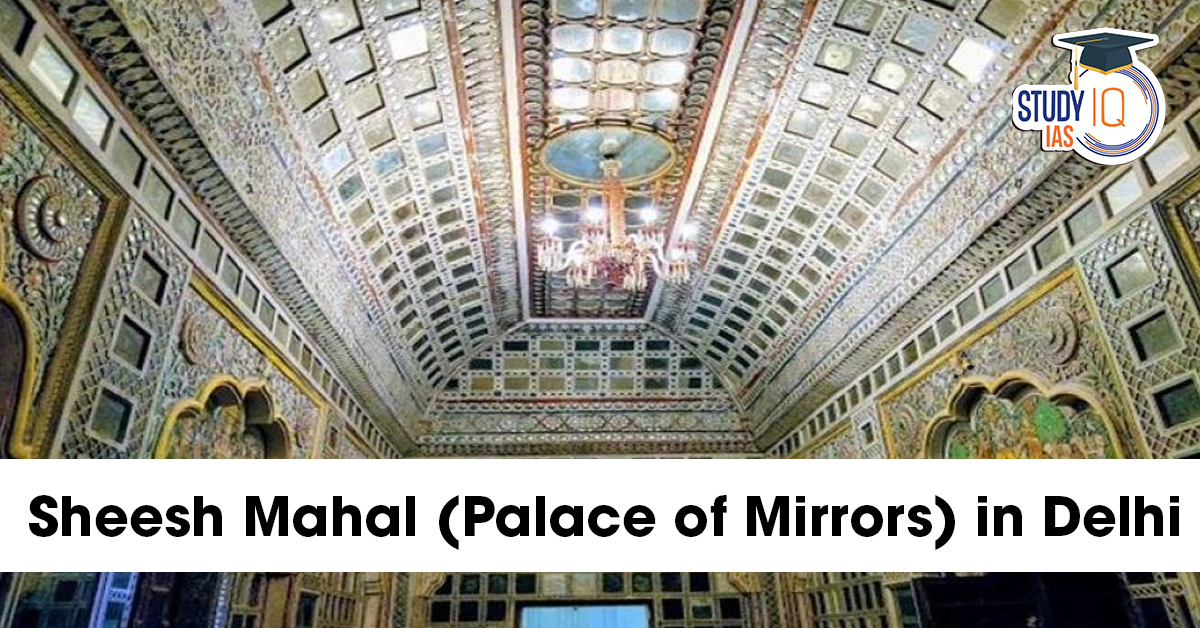Table of Contents
Context: The historic Sheesh Mahal (Palace of Mirrors) in Delhi has been restored and reopened to the public after years of conservation work by the Archaeological Survey of India (ASI).
Sheesh Mahal in Delhi
Delhi houses a large historic Sheesh Mahal (Palace of Mirrors) complex within the Shalimar Bagh complex in northwest Delhi. This beautiful 17th-century Mughal pavilion has just been reopened to the public following extensive restoration work.
- Location: Shalimar Bagh, Delhi
- Built by: A 17th-century Mughal pavilion built by Shah Jahan in memory of Aizzun-Nisha Begum (also called Akbarabadi Begum), around 1653.

- Purpose: Served as a summer retreat and pleasure pavilion for the emperor during his stay in Delhi.
- Name Meaning: Sheesh Mahal means “Palace of Mirrors” — known for its intricate use of mirror work and stucco decoration.
- Style: Mughal architecture with Persian influences
- Materials: Red sandstone, marble, and elaborate mirror inlay work (sheesha)
- Layout: Part of the larger Shalimar Bagh complex, it was designed with lush gardens and fountains, following the char bagh layout.
- It’s believed to be the site where Aurangzeb crowned himself emperor on July 31, 1658.
- Over time, parts of the garden and pavilion were damaged, including during the 1857 uprising and British occupation.
Special Features
- Arched ceilings,
- ornamental stucco work, and
- reflective mirror embellishments that illuminate the interior with natural light.
Historical Importance of Sheesh Mahal
Aside from its architectural significance, the Sheesh Mahal has a significant position in Indian history:
- It was where Aurangzeb was first crowned in 1658, a turning point in Mughal history.
- The complex was also used as a “summer retreat” for British Residents of Delhi in the colonial period, particularly by Sir David Ochterlony.
- It saw military action when British troops encamped in the garden and some parts of the building were destroyed during the Indian Rebellion of 1857.
Recent Restoration of Sheesh Mahal in Shalimar Bagh, Delhi
For years, the Sheesh Mahal and adjacent Shalimar Bagh complex (in the Archaeological Survey of India – ASI) cried for restoration and neglect. A grand restoration project started after Delhi Lieutenant Governor Vinai Kumar Saxena visited the crumbling site in January 2024. The ASI took charge of restoring the palace’s heritage aspects, while the Delhi Development Authority (DDA) restored the Mughal-style Char Bagh garden.
- The restoration employed traditional techniques and materials, such as lime concrete, lime surkhi, lakhauri bricks (thin Mughal bricks), and natural binders such as jaggery (gud), bael fruit (belgiri), and black gram paste (urad dal) to maintain authenticity.
- Along with the Sheesh Mahal, a ruined baradari (pavilion) and three heritage cottages within the complex were also renovated. Two of these cottages have been put to adaptive reuse as a ‘Readers’ Café Corner’ and ‘Café Shalimar’ for public consumption.
Reopening of Renovated Sheesh Mahal
The renovated Sheesh Mahal was reopened to visitors on July 2, 2025, by Union Culture and Tourism Minister Gajendra Singh Shekhawat, Delhi Chief Minister Rekha Gupta, and Lieutenant Governor V.K. Saxena in a milestone event for Delhi’s heritage conservation efforts.
The Sheesh Mahal at Shalimar Bagh is one of the surviving intact Mughal pavilions in Delhi beyond the complexes of the Red Fort and Humayun’s Tomb, providing an exclusive peek into the city’s glorious past and cultural heritage.


 Poompuhar Port: Ancient Sangam-Era Marit...
Poompuhar Port: Ancient Sangam-Era Marit...
 UNESCO World Heritage Sites of India Lis...
UNESCO World Heritage Sites of India Lis...
 Moran Community of Assam, History, Langu...
Moran Community of Assam, History, Langu...

























